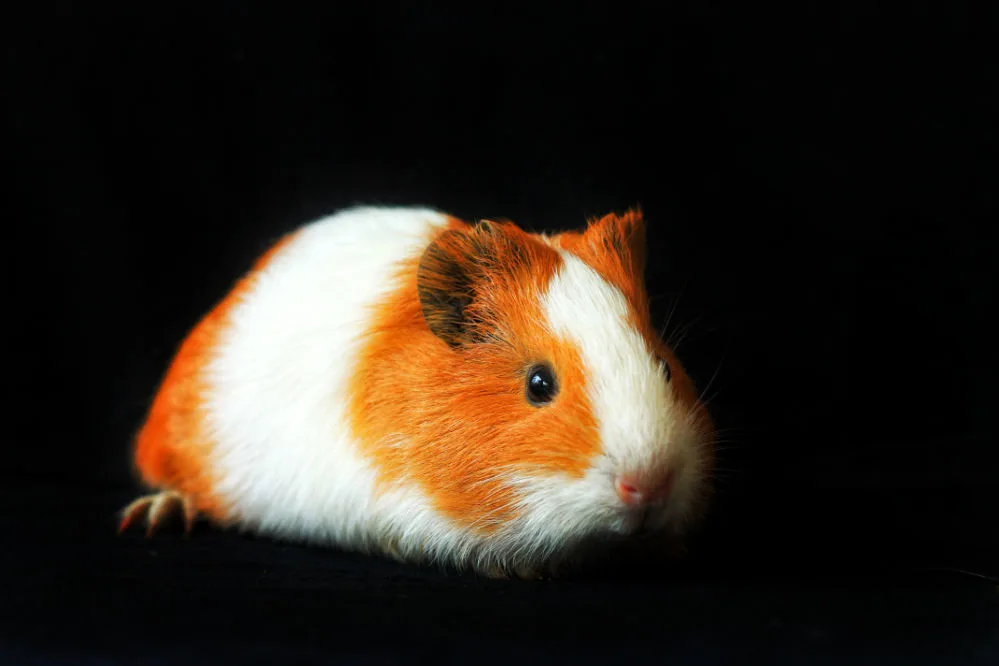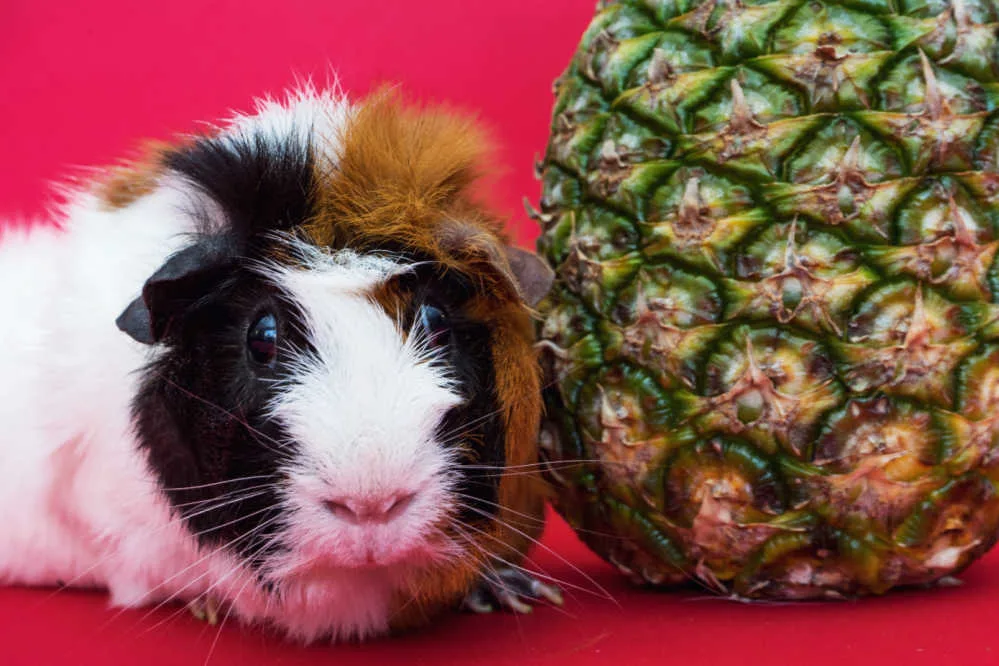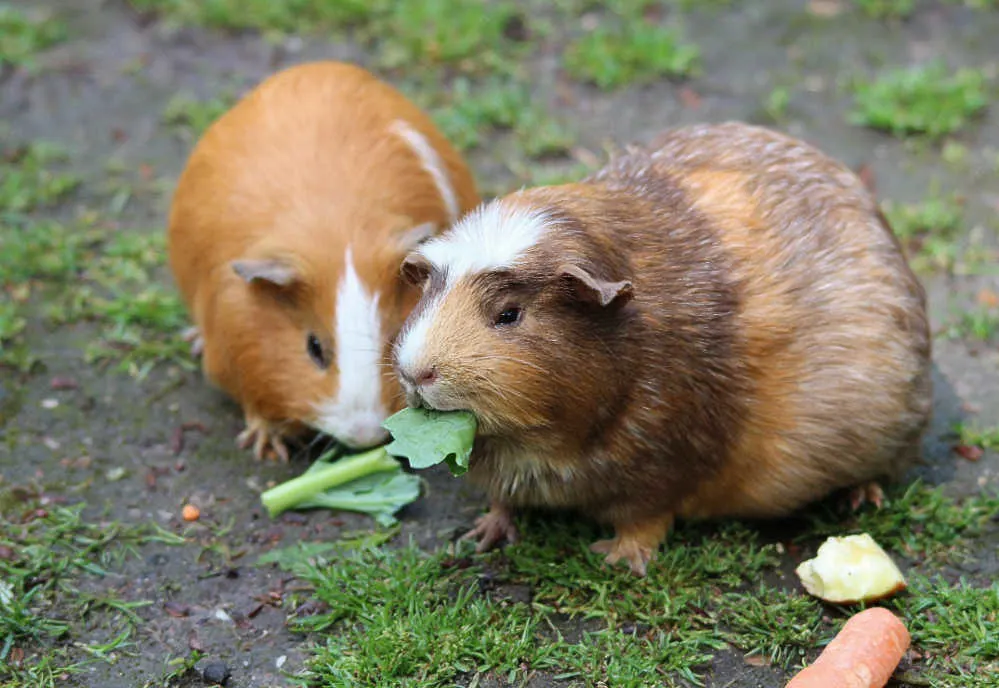Originally from South America, guinea pigs are one of the most popular small pets around. They’re social animals that are easy to take care of, love to play and cuddle, and are often mistaken for hamsters.
But did you know that guinea pigs can get quite large? While most tend to stay small and cute, these critters can grow almost the size of a rabbit or a small dog! Regardless of their size, these fuzzy furballs remain as lovable as ever.
If you’re thinking about getting a guinea pig, you’ll need to be ready to take care of them at whatever size they are. So, read on for tips on how to handle these great pets at all sizes.
Guinea pig size at birth
Expecting mothers all want to know one thing: how big will my baby be? For human babies, doctors can use ultrasound to get a pretty good idea. But for guinea pigs, there’s no need for any high-tech devices — you can simply look at the father’s size.

Guinea pigs are born small but grow rapidly. You can expect young guinea pigs to measure around three to four inches (eight to ten cm). As for average weight, baby guinea pigs can be approximately three and a half ounces (100g). They’re born completely furred with fully developed eyes, ears, and limbs and can immediately move well.
Obviously, there will be a lot of variation even in the same litter. This depends on factors like health, the mother’s diet, the litter size, gender, and birth order. A bigger litter will lead to small pups, and males are generally larger than females (more on this later).
How quickly do guinea pigs grow?
While they’re born small enough to comfortably fit in the palm of your hand, this won’t be the case for long. These small pets grow rapidly and, depending on the individual, can double in size in just eight weeks.
A few weeks more, you’ll likely need to hold them with both arms, and they’ll continue filling out depending on diet and health. You can expect these creatures to be around for four to eight years, which is their typical lifespan.
When do guinea pigs stop growing?
So, you now know that guinea pigs have a rapid growth rate, but when do they reach maturity? These cute cavies start with rapid growth that slows down until they reach full size at about 14 months of age.
They’re considered fully grown and won’t shrink or fill out much more at that age. However, this isn’t the case for all these rodents, as some stop or continue growing earlier and later.
How big can guinea pigs get?
Now, onto the main question for the day: how big do guinea pigs get? Well, there’s not a one-fits-all answer to this query. Depending on their gender, breed, and other external factors, they may end up at different sizes.
To get the answer, let’s look at these factors in detail below.
Male vs female guinea pigs
Like humans and, basically — every other species — male and female guinea pigs differ in size.
Male guinea pig sizes
Typically, male guinea pigs will be longer, taller, and bigger than their female counterparts of the same breed. Boars, as they’re called, on average can weigh around 2.6 pounds (1,100g) at the age of maturity.
As for length, a typical boar can be anything from eight to twelve inches (20 to 25 cm), depending on their breed. Of course, the bigger breeds tend to be bigger, and the smaller breeds smaller.

Female guinea pig sizes
Like their male counterparts, sows can be bigger or smaller than average, depending on their breed.
Typically, you can expect a female guinea pig to weigh between one and a half and two pounds (700 to 900 g). These cute critters can be measured between eight to ten inches (20 to 25 cm).
Boars are usually 20-30% bigger than sows. These aren’t massive differences, though, so it can be hard to distinguish between males and females by eyeing them. The best way is to check their genital areas to ensure you don’t accidentally end up with a breeding pair.
Different breeds reach different sizes
Guinea pigs may share the same rounded shape across breeds, but they are all different. The American Cavy Breeders Association (ACBA) officially recognizes 13 breeds. However, there are just over 50 guinea pig breeds, according to the British Cavy Council. These vary in characteristics and sizes.
There are probably even more undocumented breeds of guinea pigs that aren’t officially recognized.
Some guinea pigs are typically large, while others are smaller. This is something to remember when trying to get a brand-new guinea pig. Any guesses on the biggest and smallest ones?
Biggest guinea pig breeds
The Rex guinea pig is easily the largest in the world by a comfortable margin. As an adult, Rex boars typically reach 17 inches (43 cm) in length. They can weigh as much as three pounds (1361 g) at maturity. Despite their relatively astonishing size, these are gentle giants with a friendly nature and low maintenance.
Fun fact, this breed is not officially recognized by the ACBA.

There are a ton of guinea pig breeds that are massive in size, too, including the following:
- The Abyssinian guinea pig
- The Teddy guinea pig
- The Himalayan guinea pig
- The Peruvian guinea pig
- The Silkie guinea pig
- The Lunkarya guinea pig
All the above usually top out at 12 inches (20 cm).
Smallest guinea pig breeds
In contrast to the massive Rex guinea pig, the American guinea pig is the smallest of all these rodents. They measure at a maximum of nine inches (22 cm) at old age but can astonishingly weigh three pounds (1,361 g).
A close second to these domesticated guinea pigs is the Texel, a relatively new breed that generally won’t grow past 10 inches (25 cm).
Other breeds that are on the smaller side of things include the following:
- The Skinny guinea pig
Biggest guinea pig ever
Now, for some trivia to bolster your guinea pig knowledge even further. Can you guess what the biggest guinea pig ever is?
Well, that would be the extinct Phoberomys, which holds the record for being the largest rodent ever. Its fossils were found in what is now Venezuela, and it’s believed to have existed eight million years ago. According to estimates based on its bones and teeth, it weighed around 1,543 pounds (700 kg) and was nine feet (2,74 m) long.
The Rex guinea pig would look like a grain of rice next to its feet. In comparison, the largest modern rodent, the capybara, weighs just 145 pounds (66 kg) at most.
How to measure a guinea pig
Measuring a guinea pig every now and then is essential to ensure your furry baby is in excellent health. The best way to check and judge its growth is through its weight, as any guinea pigs that fall out of the typical range are under or overweight. You may also want to record weights to note any changes up or down that could indicate a health problem. On the other hand, their length won’t indicate much regarding health, especially once they’ve reached their mature size.
While measuring may seem easy in theory, these cute critters love moving, making it difficult. You can overcome their hyperactivity by using a scale and distracting them with a small treat.
Other factors that affect the size of a guinea pig
As mentioned earlier, a number of factors affect the size of a guinea pig at maturity.
- Gender plays the most significant role, as males are usually bigger than females, regardless of breed. However, they will stop growing at around the same age, with males growing faster.
- The breed also plays an important role, as some breeds are larger than others.
Another critical factor is the diet and type of foods that they eat. Guinea pigs that are well-fed and well-taken care of by responsible pet owners should grow healthy.

Required diet
Guinea pigs need a varied diet to be fully healthy. This includes an unlimited amount of hay, with one of the best being Timothy hay. Other alternatives include alfalfa hay and other types of grass hay.
In addition to the hay, you’ll need to give them pellets. They also need around 2.7 – 3.4 fluid ounces (80 – 100 mls) of fresh water per day, which you can provide via a water bottle. It’s recommended that these be inverted glass bottles as these adorable critters tend to chew at plastic containers.
You can also give guinea pigs safe fruits and vegetables. Check out this guide on whether guinea pigs can eat apples or not for more information on that. However, you’ll need to keep these fresh snacks to a minimum, so they don’t become overweight.
What cage size should you get?
A guinea pig’s expected weight and size are uber important for picking out the correct cage or hutch. Perhaps the most important thing to consider with this purchase is how many guinea pigs you will have.
A general rule of thumb is to ensure that whichever cage or hutch you buy will afford the guinea pigs at least two square feet (0.18 square meters) per pig.
Guinea pig size guide in conclusion
Hopefully, this guide has helped you answer the question of how big guinea pigs grow, regardless of whether you’re looking to adopt or already have one. Depending on the breed and gender you have, you may be in for an affectionate, gentle giant or a cute small critter. Either way, you’re guaranteed a great time.
Steph Dyson is a travel journalist by trade but a lover of all small pets. She’s been a pet mum to everything from gerbils to guinea pigs, rabbits to hamsters, and fish to dogs of all shapes and sizes. She wants to share her years of experience with small pets and make Small Pet Guides the go-to website for pet owners seeking information and care advice.

